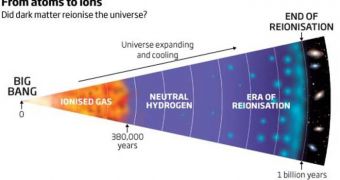Theories about what happened in the early Universe, after the Big Bang, exist in abundance, but the issue is that no one knows for sure what forces acted on the hot ionized gases that were formed following the greatest explosion ever. That is to say, after the first moment, the Universe was filled with ionized gas, which promptly began to expand. After nearly 380,000 years, the entire mixture started cooling, and something ripped the hydrogen atoms that made up almost all matter into protons and electrons. This allowed for its neutralization, an epoch that was afterwards followed by the reionization period, which ended about one billion years after the Big Bang.
Fermilab experts Dan Hooper and Alexander Belikov seem to think that dark matter may have been the driving force behind the separation that occurred in hydrogen atoms. Despite the fact that it has never been seen before, dark matter is thought to make up for about 85 percent of all matter in the Universe. It has created the scaffolding that keeps galaxies together, and also the filaments on which stars, clouds, and other types of celestial formations travel and collide with each other. Some theories even say that it was dark matter that first channeled gas and dust into forming the first galaxies.
Dark matter is believed to be made up of particles so large, that they annihilate each other if they collide, creating enormous amounts of gamma-ray radiation. Thus far, its existence has only been mathematically inferred, through observations of its effects on gravity coming from galaxies far away. The duo believes that when the Universe was first created, dark matter clouds came together under the strong gravity, and that a great deal of the particles in these formations interacted with and annihilated each other. The ensuing gamma-ray bursts would have sufficed to rip electrons from hydrogen atoms, NewScientist reports.
The process would have been self-sustaining, the experts think, because a gamma-ray burst would have knocked off an electron from a hydrogen atom, which, in turn, would have stripped another electron from another atom. “A single gamma ray might reionize 1,000 hydrogen atoms. The mechanism could easily have reionized the universe,” Hooper said.
“We have no evidence yet that any dark matter has ever annihilated. I am not saying it is wrong, but it sounds a bit too contrived for me to eagerly accept it,” Goddard Space Flight Center expert Charles Bennett, who is the principal investigator on NASA's WMAP satellite, added. The observatory has been studying the reionization epoch for quite some time now, and has even offered a map of the Universe that contains new and interesting data. The main objection that Bennett has is that he cannot conceive using an unexplained phenomenon to explain another similar one.

 14 DAY TRIAL //
14 DAY TRIAL //